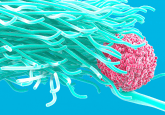Multicenter collaboration enhances understanding of diffuse glioma subtypes

Results from a study carried out by an international consortium of researchers have revealed new information regarding the distinct subgroups of diffuse glioma.
Diffuse glioma accounts for approximately 80 % of adult brain cancers and it is hoped that a greater understanding of these disease groups could facilitate improved clinical outcomes. The research was published online in the 28th January issue of the journal Cell.
The study, led by The University of Texas MD Anderson Cancer Center (TX, USA), Columbia University Medical Center (NY, USA) and the University of Sao Paulo’s Ribeirao Preto Medical School (Sao Paolo, Brazil), involved analysis of data from 1122 samples of diffuse glioma from lower to higher grades – the largest multiplatform analysis to date of adult diffuse glioma, grades II–IV.
There are currently four classifications of glioma, including oligodendroglioma, olioastrocytoma, astrocytoma and glioblastoma – all of which are graded from grade II–IV. However, treatment-informing diagnosis varies between clinicians. This study aimed to address this by comprehensively analyzing molecular profiling data from The Cancer Genome Atlas (TCGA).
“TCGA data allowed us to identify diffuse glioma subgroups with distinct molecular and clinical features and shed light on mechanisms driving disease progression,” explained Roel Verhaak from The University of Texas MD Anderson Cancer Center.
At present, pathologists classify low- or high-grade glioma based on tumor tissue characteristics under the microscope. Commenting on this method, Antonio Iavarone from Columbia University Medical Center said: “While this approach is generally good at distinguishing between gliomas that are clearly very aggressive and those that are relatively slow-growing, it misses the mark in a significant percentage of cases, leading to inappropriate treatment. By looking at the molecular makeup of these tumors, we now have a much more precise way of predicting which tumors are more likely to grow rapidly and can prescribe treatments accordingly.”
“The epigenomic data defined by profiling DNA methylation levels for each of our glioma patient tumor samples, allowed us to determine with accuracy which patient will present the best clinical outcome and the worst,” added Houtan Noushmehr from the University of Sao Paolo. “By looking at the molecular makeup of these tumors, we now have a much more precise way of predicting which tumors are more likely to grow rapidly and can prescribe treatments accordingly. Our work lays an important foundation to further investigate the mechanisms of epigenetics associated with glioma tumor biology.”
The development of novel therapies for glioma has been delayed by an incomplete understanding of glioma classification. The investigators were able to define a complete set of genes associated with the patient samples and utilized molecular profiling to enhance disease classification. This enabled them to identify molecular correlations and provide insight into disease progression from low to high grades.
“This study has expanded our knowledge of the glioma somatic alteration landscape, emphasized the relevance of DNA methylation profiles as a method for clinical classification, and has linked TERT (telomerase reverse transcriptase) pathway alterations to telomere maintenance,” explained Verhaak. “Combined, these findings are an important step forward in our understanding of glioma as discrete disease subsets, and the mechanism driving glioma formation and progression.”
Source: University of Texas MD Anderson Cancer Center news release




